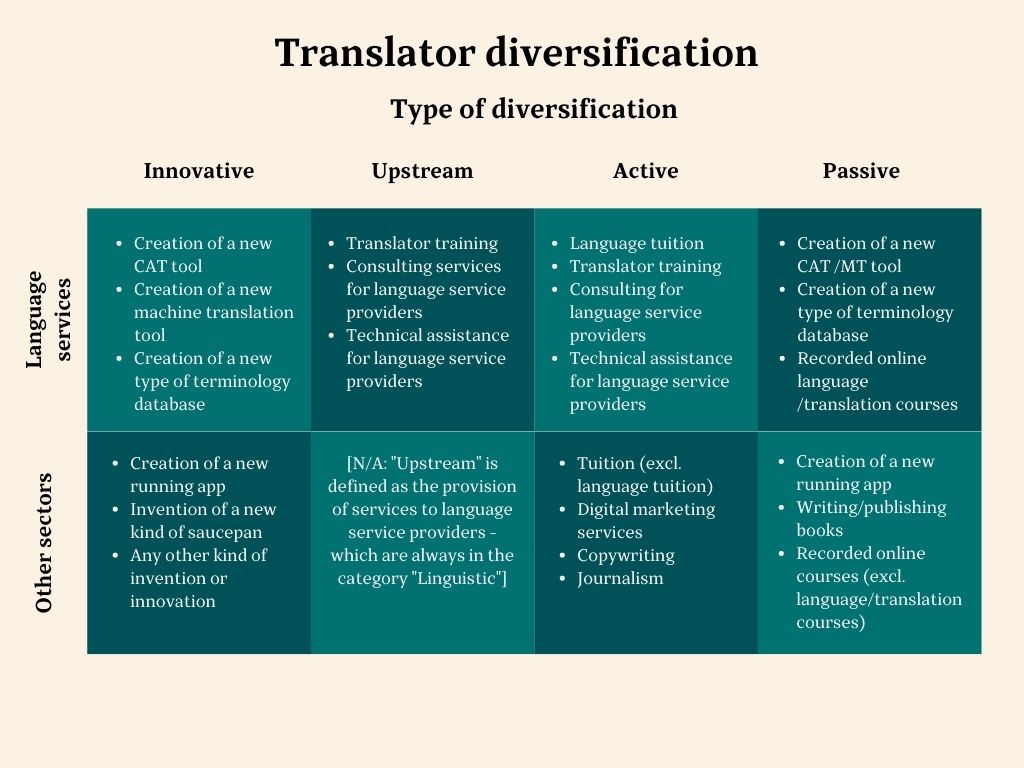What is good for investors is good for translators
Diversification has always been a smart idea for business. Just as investors spread their risk by placing their money into different investments across multiple sectors, businesses can protect themselves against risks of one business sector/product by expanding their operations to cover others.
For translators, diversification is fast becoming a necessity rather than just a smart idea. The rapid development of machine translation technology means that more and more work which used to be done by humans can now be done by machines – or at least done more productively with the aid of machine translation.
While it is still too pessimistic to say that human translators are going to become obsolete any time soon – the rise of machine translation & AI have changed the landscape of the industry and the character of the job forever. Translators need to be aware of those transformations and adapt their business models accordingly.
Of course, change is unsettling – but it also opens up a host of lucrative business opportunities.
Here are some ways in which translators might diversify to take advantage of those new chances and spread existing risk.
Language services
The most obvious way to diversify for translators is within the language services industry itself. The advantages of this are clear: having already operated within the industry, one already knows the demands, the applicable standards, the opportunities and the risks. It may be necessary to acquire certain new skills to diversify, but you don’t have to spend a long time acquiring basic industry knowledge beforehand.
In fact, many translators offer other language services than translation already without knowing that they actually represent a first level of diversification.
Here are some ways a translator might diversify within the language services sector:
- Post-editing of machine translation raw output
- Subtitling
- Review and correction of non-native copy
- Terminology management
- One-to-one conversation, language tuition
Other sectors
Some translators might wish to spread their wings a little and look outside the language services sector for additional income streams. The different opportunities for this are too numerous to list. However, here are a few ways in which translators might add to their business models:
- Teaching of subjects other than languages
- Digital marketing (e.g. SEA, SEO, content marketing)
- Writing books
- Copywriting
- Technical writing
- Setting up an online shop
Diversification doesn’t have to been considered solely from the point of view of which sector the new income stream derives from. You can also consider the issue through the lens of the type of diversification.
Types of diversification
Passive income
Good examples of passive income sources are books or online courses which – once written or recorded – can be sold without any further effort (apart from updates etc.). These sources of income are excellent insurance for freelancers, as they will continue to provide an income if you are unable to work for a while, i.e. due to injury or accident.
Active income
Active income requires effort and personal presence to provide the service. Classroom teaching is an example: you have to be there in person to achieve the income.
Upstream services
- If you want to diversify but still stay close to the language services sector, then you may consider “swimming upstream”, i.e. to provide services to translators. This could include CAT tool training sessions or coaching
Innovative
This is rather rare, but the particularly inventive or entrepreneurial might come up with a new and innovative idea (either within our without the language services sector) which they develop and eventually launch on the market. Such innovative ideas could include:
- Building a new CAT/MT Tool
- Building a new kind of legal terminology database, e.g. for a certain industry
- Any other invention or innovation (e.g. an app)
These projects involve considerable risk and great uncertainty. However, the potential rewards are enormous.

Tips
If you have decided to diversify your business model, there’s a few things which you need to keep in mind to keep all the balls you are juggling in the air.
1. Get really good at project and time management
When deciding whether to diversify into a certain area or take on a certain project, it’s important to know how much time it is going to require and what sort of a schedule you are going to have to work to in order to complete the work. As far as is possible, you are going to have to plan your translation projects around the other work.
Because translation projects often come up at short notice, this will be a matter of saying yes or no to the translation project according to the other work which you have to do at the time. Regular translation projects will require a bit more active scheduling to avoid conflicts.
2. Keep track of your deadlines
There is nothing that makes you look more unprofessional than forgetting or failing to meet deadlines. Make sure that you have systems in place which remind you of upcoming deadlines or tasks which have to be done by a certain date. I find the Microsoft Outlook calendar meets my needs but there are many other tools out there.
3. Know your limits and don’t be afraid to say “no”.
When you are self-employed, there is a certain temptation to accept everything which comes your way. This is probably due to self-employment being a bit of a feast-or-famine situation. Whatever the reason, it is so easy to bite off more than you can chew and end up missing deadlines, delivering sub-standard work or sliding into burnout.
Be realistic about your capacities and – if in doubt – better say no.
4. Don’t be afraid to say “yes”
We’ve already talked about the ability to say “no”…but it is just as important to be able to say “yes”! Expanding into a different area necessarily involves a learning curve and having to do things for the certain time. That can be pretty scary and uncertain and you find yourself asking yourself whether you can do this.
In such situations, it’s worth taking a leaf out of the British entrepreneur Richard Branson’s book. He said: “If somebody offers you an amazing opportunity but you are not sure you can do it, say yes – then learn how to do it later!” Amen to that!
5. Stay curious, keep your eyes open, keep on experimenting
Offering a new product or service as part of your business model is the culmination of a long process of coming up with ideas, developing those ideas, developing/products and services, market research etc. There is no guarantee that any particular idea will even get beyond the “thinking vaguely about it” phase, let alone to market to become The Next Big Thing.
The more ideas and experiments you have bubbling away, the better your chances of coming up with one that goes the distance and ends up making you money. Therefore: never stop having ideas, never stop thinking and looking for opportunities. Diversification is a mindset, not a one-off event.

